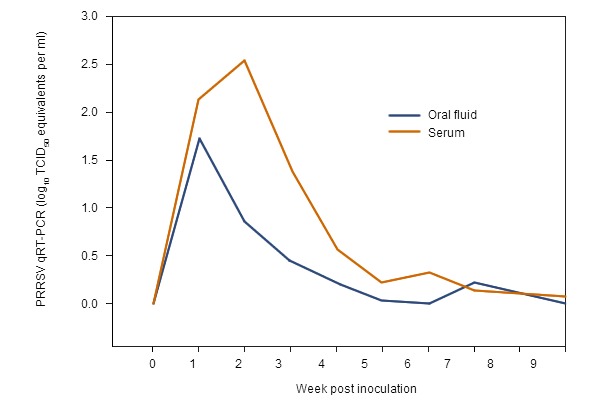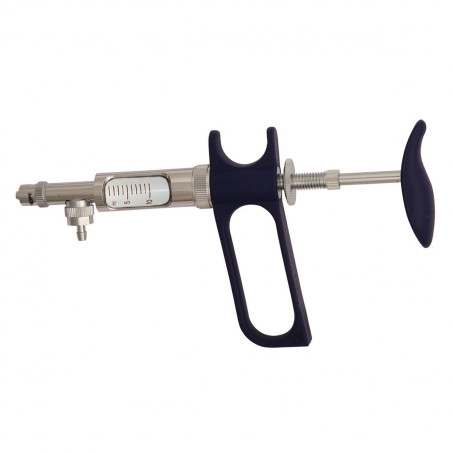Paper
Detection of Porcine reproductive and respiratory syndrome virus infection in porcine oral fluid samples: a longitudinal study under experimental conditions. John Prickett, Robert Simer, Jane Christopher-Hennings, Kyoung-Jin Yoon, Richard B. Evans and Jeffrey J. Zimmerman. J VET Diagn Invest 2008 20: 156 DOI: 10.1177/104063870802000203

Paper summary
What are they studying?
This study was realized to determine if PRRSV or PRRSV antibodies are present in oral fluids (OF), their life span in the OF and the influence of age
How do they study it?
48 PRRSV-free pigs were divided in 3 age groups (4, 8, and 12 weeks). 12 pigs in each group were inoculated with PRRSV intramuscularly at day 0, while 4 pigs were left as controls. After inoculation, serum, buccal swabs and oral fluids were collected through 63 dpi, and analysed by qRT-PCR, ELISA and IFAT.
Pen-based oral fluid samples were collected twice weekly through 61 dpi by suspending a length of 3-strand twisted cotton rope in each pen of 4 or 6 pigs.
What are the results?
PRRSV was detected for 5 weeks in serum and 4 weeks in OF. Pig age had no effect on the quantity or duration of virus detection in oral fluid samples (Table 1 shows the qRT-PCR results). Antibodies were detected in OF by ELISA and IFAT albeit in low levels.
Table 1. Oral fluid, serum, and buccal swab PRRS real-time quantitative reverse transcription polymerase chain (qRT-PCR) reaction categorical results by post-inoculation time.
| Pen-based results | Individual pig results | ||||
| Pen-based oral fluid samples | Serum | Serum | Buccal swabs | ||
| Week | Laboratory A | Laboratory B | Laboratory A | Laboratory A | Laboratory A |
| 1 | 8 (100%) | 8 (100%) | 8 (100%) | 35 (97%) | 7 (20%) |
| 2 | 7 (88%) | 8 (100%) | 8 (100%) | 36 (100%) | 3 (8%) |
| 3 | 6 (75%) | 4 (50%) | 8 (100%) | 32 (89%) | 2 (6%) |
| 4 | 7 (88%) | 6 (75%) | 7 (88%) | 18 (50%) | N/A |
| 5 | 2 (25%) | 3 (38%) | 6 (75%) | 10 (28%) | N/A |
| 6 | 0 | 3 (38%) | 6 (75%) | 12 (33%) | N/A |
| 7 | 1 (13%) | 1 (13%) | 5 (63%) | 7 (19%) | N/A |
| 9 | 0 | 0 | 3 (38%) | 5 (14%) | N/A |
The following figure shows the detection of PRRSV in serum and OF by quantitative reverse transcription polymerase chain reaction (qRT-PCR) by post-inoculation week, confirming a high correlation between serum and oral fluid in PRRSV detection.

Figure 1. Serum and oral fluid PRRSV qRT-PCR results by post-inoculation week
What conclusions are drawn from this work?
The use of oral fluids in veterinary diagnostic medicine has been minimal; however, the results of this experiment suggest that pen-based oral fluid sampling could be an easy, efficient, cost-effective approach to PRRSV surveillance in swine populations.
PRRSV was detected by qRT-PCR in oral fluid samples for approximately 4 weeks.
|
Control of PRRS in positive pig farms is not always easy. It is true that we have vaccines, but their effectiveness is limited, and thus control cannot be based solely on them. Correct adaptation of gilts is an essential element of PRRS control, but we musn't forget all those measures aimed at preventing the internal spread of the virus such as, most importantly, a strict batch management. But, how can we ensure the results of the measures are what we expect? The possibility of detecting PRRS virus and its antibodies in oral fluids is a great help to control the disease in the field. It is true that analysis of individual animals is not possible with oral fluids (we analyse all the animals in a pen), but in animal production, this is an advantage when we are trying to establish the dynamics of infection within a population, since one result represents what were once several samples. The ease with which samples can be taken allows for a higher testing frequency and a greater representativeness of the results, since they include a bigger number of pigs. When it would be indicated to use OF diagnosis? At replacement control points —on arrival and after the adaptation process—, in order to ensure the gilts have developed defenses against the virus (ELISA-positive) but have managed to overcome the viraemia (PCR-negative) before introducing them in the farrowing quarters. Also at the different production batches control points. PRRS virus infections are not static on a farm, and as our actions yield positive results, the dynamics of the infection change. For example, the stricter the control applied, the later the virus circulation and the more important it is to control side infections (from previous batches). Diagnosis in oral fluids, in this case, allows us to increase the control frequency —due to the ease with which it is achieved—, and effortlessly control risk subpopulations, such as animals with a slow growth rate, always present in a farm. |











